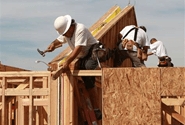Analysis

May 16, 2018
Housing Starts Dip in April on Falling Multifamily Construction
Written by Sandy Williams
Housing starts slowed in April, falling 3.6 percent from revised March data to a seasonally adjusted annual rate of 1,287,000. Compared to a year ago, starts increased 10.5 percent, reports the National Association of Home Builders (NAHB).
Most of the April decline was a result of a 12.6 percent plunge in multifamily housing after making gains in March. Multifamily starts of five units or more were at a rate of 374,000. Single-family housing starts were relatively flat, gaining 0.1 percent from March for a rate of 894,000.
Starts declined in all regions except the South, which saw a 6.4 percent total monthly gain and a jump of 17.2 percent for single-family homes.
Permit authorizations, an indicator of future construction, hit a seasonally adjusted annual rate of 1,352,000. Housing permits were 1.8 percent below the revised rate of 1,377,000, but 7.7 percent higher than April 2017.
Single-family permit authorizations grew 0.9 percent from March to a rate of 859,000, while multi-family housing permits declined 7.4 percent.
The biggest decline regionally was in the Northeast, down 31.9 percent from March. The Midwest and West posted declines of 4.4 percent and 13.2 percent, respectively. Permit authorizations in the South jumped 12.0 percent.
“We expected some pullback after such a strong March report, but housing starts remained at very healthy levels in April,” said NAHB Chairman Randy Noel. “With homeownership rates on the rise, demand for single-family homes should continue to spur production in the months ahead.”
“Single-family starts are up 8.3 percent for the first four months of the year relative to the start of 2017, which is higher than our forecast and bodes well for the rest of the year,” added NAHB Chief Economist Robert Dietz.
“However, builders must manage supply-side hurdles, such as ongoing building material price increases and shortages of land and labor, to meet growing housing demand. Lumber prices continue to rise, with recent increases adding more than $7,000 to the price of an average single-family home,” he said.







